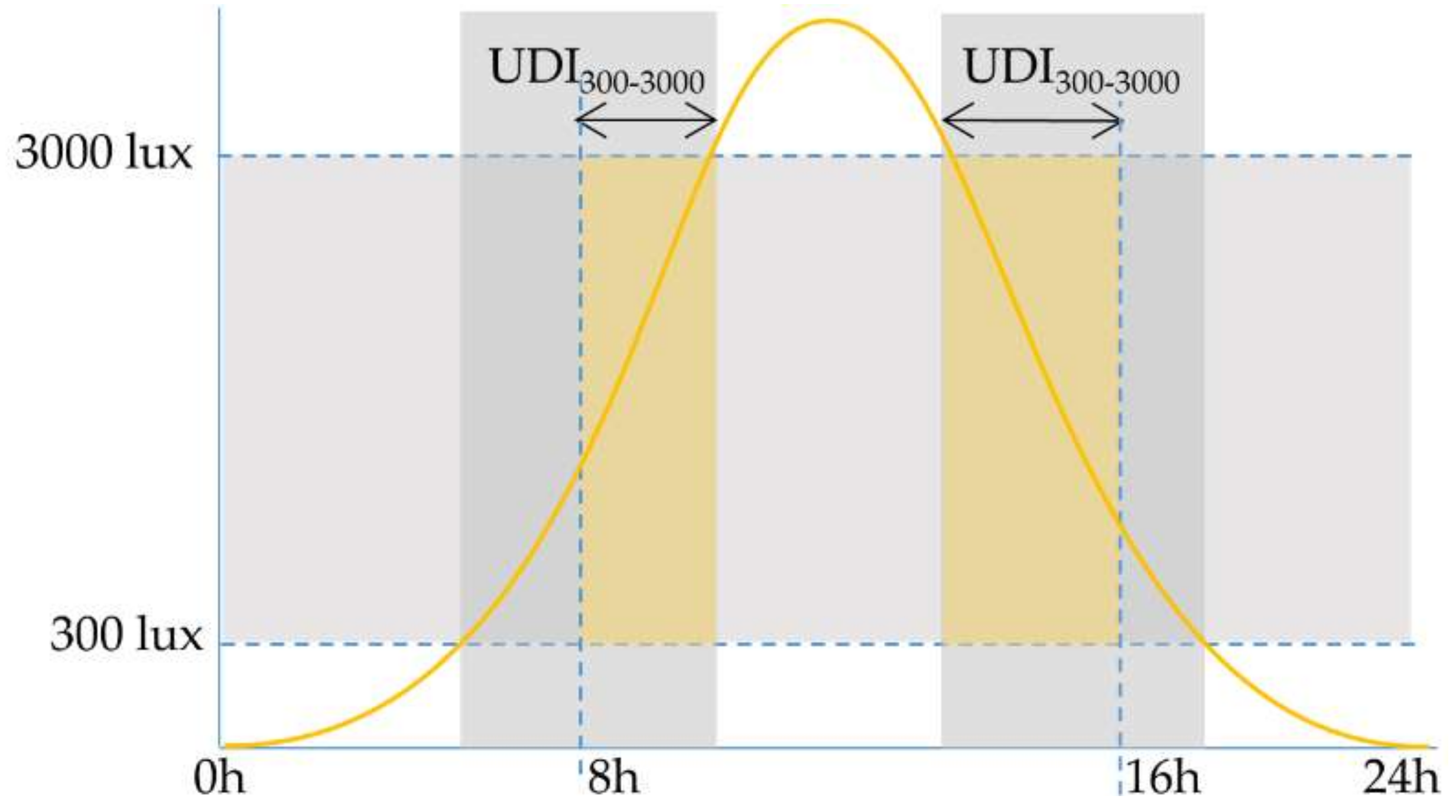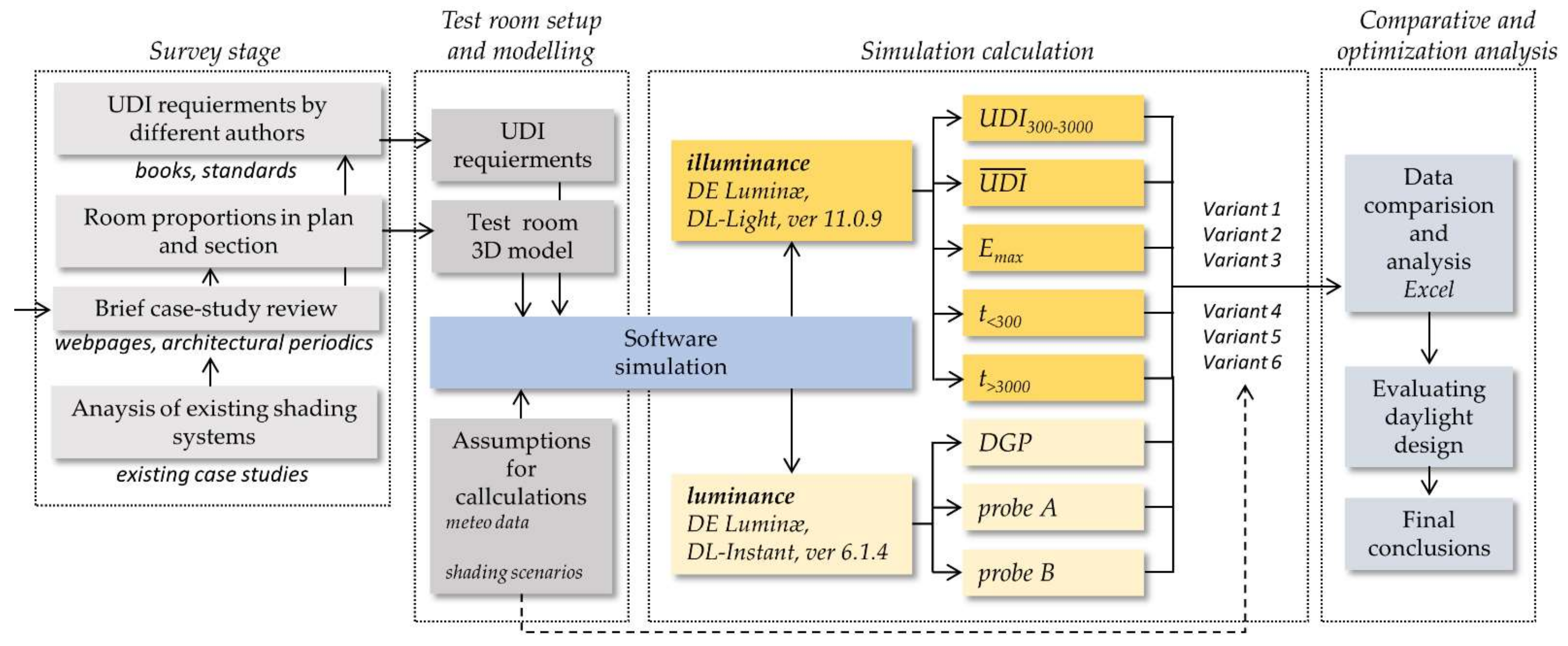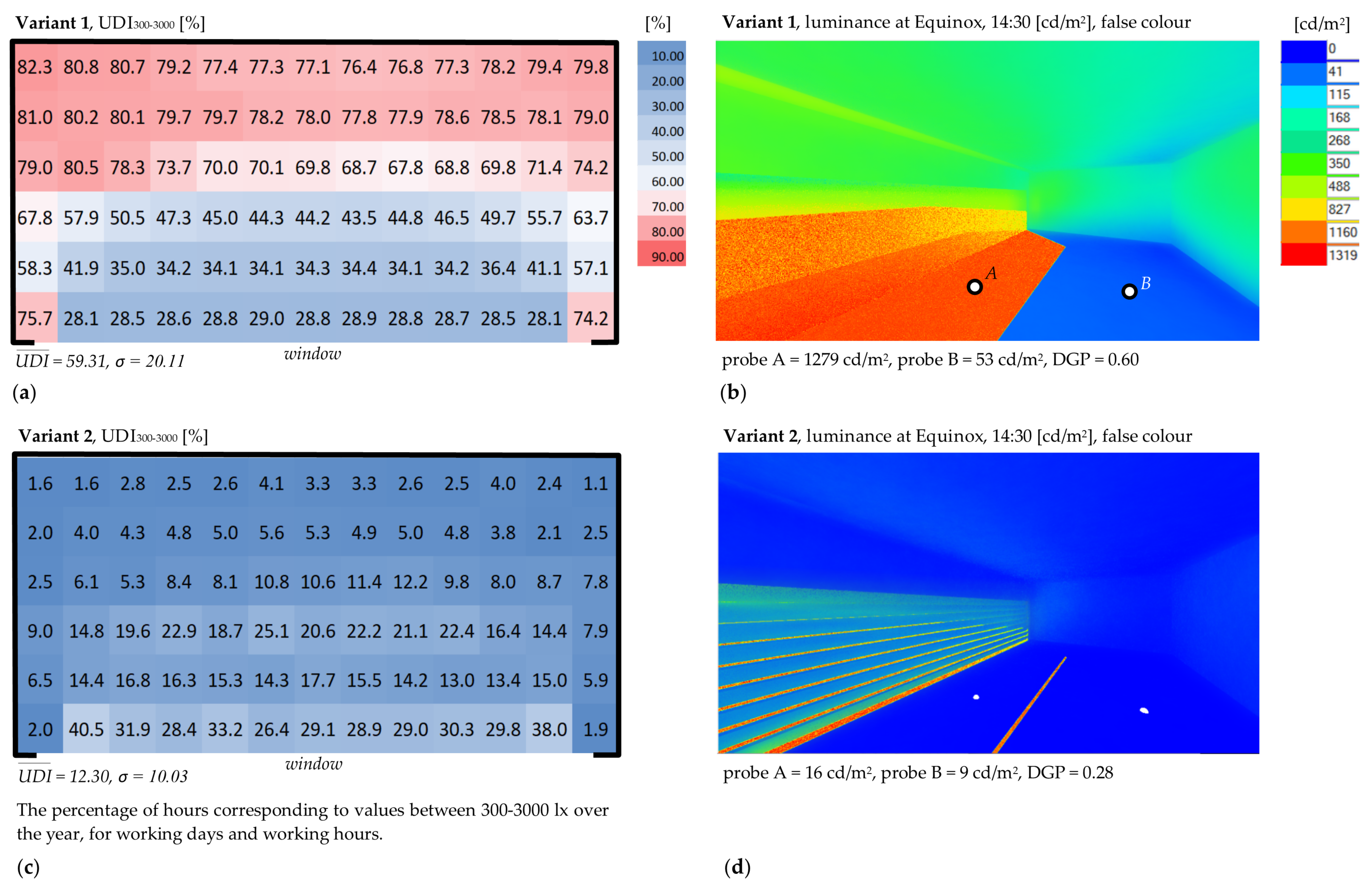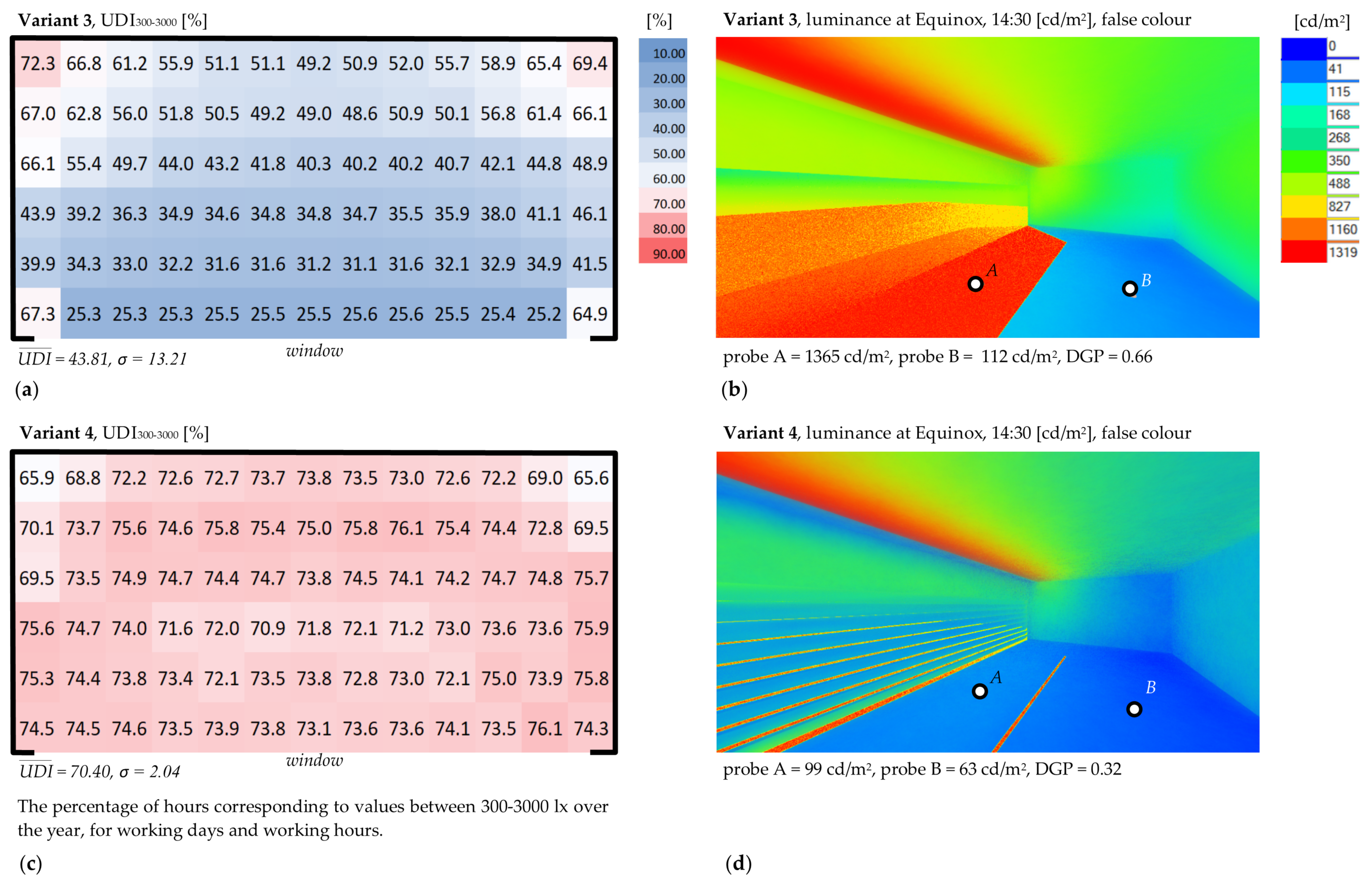An Evaluation of Useful Daylight Illuminance in an Office Room with a Light Shelf and Translucent Ceiling at 51° N
Abstract
:1. Introduction
Objective of the Study
2. State of the Research
2.1. Method and Eligibility Criteria
2.2. Light Shelf
2.3. Anidolic Daylighting System
2.4. Shading Elements
2.5. Maximum Discomfort Daylight Levels
2.6. The Current Empirical Research
- A new typology of an office room that is illuminated by two sources of daylight: a standard window and through LS and TC. A few similar daylight distribution scenarios have been previously analyzed, as cited above, but none of them featured a plenum with a translucent ceiling at the entire surface of the test room. This type of daylight distribution is used in museums but not in offices; at least, no analytical simulation study of this type is known to the author. The fact that the main strategy adopted is to further the increase in visual comfort (an increase in UDI and reduction in DGP) also demonstrates the innovativeness of the presented approach. UDI was successfully used in a previous publication by the author to evaluate the level of daylight [50].
- A computer-aided procedure is applied, which is based on the calculation of illuminance over the entire year at the level of the working plane. This procedure uses a simulation performed by the Radiance engine. This innovative approach incorporates different scenarios for the operation of external louvers that adjust according to the illuminance level at the work plane in the office room.
- A computer-aided procedure is applied, which uses real weather data in an EPW (Energy Plus Weather) file that represent actual climate and daylighting conditions, recorded at the airport Strachowice in the city of Wroclaw (51°10′ lat. N, 17°03′ long. E), WMO station identifier 124240. The data set was “developed for use in energy calculations for buildings and dwellings including building certificates and building energy research” [51]. A set of 61 weather files was developed by the Polish Ministry of Infrastructure based on data from IMGW (Institute of Meteorology and Water Management, National Research Institute, Poland). The weather data were retrieved from the EnergyPlus weather web page (https://energyplus.net/weather (accessed on 14 October 2021).
3. Method
3.1. Simulation Software
3.2. Measures Adopted in the Current Study
- Useful daylight illuminance UDI300–3000 and mean ;
- The average number of hours in the simulated year for which the illumination exceeded 3000 lx at the working plane t > 3000;
- The average number of hours in the simulated year for which the illumination was lower than 300 lx at the working plane t < 300;
- Maximal illuminance value in the year Emax;
- Mean daylight uniformity Umean for values of illuminance at equinox 14:30;
- Daylight glare probability DGP for values of luminance at equinox 14:30;
- Luminance probe values in cd/m2;
- Standard deviation σ and uniformity U300–3000 for final UDI300–3000 distribution.
3.2.1. UDI300–3000 and
3.2.2. Uniformity of Illuminance
3.2.3. Daylight Glare Probability
3.2.4. Luminance Evaluation
3.3. Simulation Setup for UDI and DGP
3.4. Analysis Assumptions for Calculations of Daylight
3.5. Sequential and Gradual Sequence of Simulation
4. Results
4.1. First Phase of the Simulation
4.2. Second Phase of the Simulation
4.3. Third Phase of the Simulation
5. Discussion
5.1. Variants without Louvres
5.2. Variants with Louvres
5.3. Visual Comfort
6. Conclusions
6.1. Limitation of the Study
6.2. Future Research
Supplementary Materials
Funding
Institutional Review Board Statement
Informed Consent Statement
Data Availability Statement
Conflicts of Interest
Nomenclature
| LS | light shelf |
| TC | translucent ceiling |
| UDI | useful daylight illuminance |
| UDI300–3000 | useful daylight illuminance with the range of 300–3000 lx |
| mean UDI | |
| DGP | daylight glare probability |
| t<300 | the average number of hours with illuminance under 300 lx |
| t>3000 | the average number of hours with illuminance over 3000 lx |
| Emax | maximal illuminance |
| Umean | mean daylight uniformity |
| U300–3000 | uniformity for the final UDI300–3000 distribution |
| σ | the standard deviation for the final UDI300–3000 distribution |
References
- House of Commons. Rights to Light Law Com. 356 HC 796 2014-15; House of Commons: London, UK, 2014; 243p, ISBN 9781474112581.
- Hellinga, H. Daylight and View. The Influence of Windows on the Visual Quality of Indoor Spaces. Ph.D. Thesis, Delft University of Technology, Delft, The Netherlands, 2013. [Google Scholar]
- CIBSE. Lighting Guide LG7/15; CIBSE: London, UK, 2015; p. 113. ISBN 9781906846589. [Google Scholar]
- Sustainable Development Goals, United Nations Department of Global Communications. May 2020. Available online: https://www.un.org/sustainabledevelopment/wp-content/uploads/2019/01/SDG_Guidelines_AUG_2019_Final.pdf (accessed on 13 September 2021).
- Brzezicki, M. An evaluation of annual luminous exposure from daylight in a museum room with a translucent ceiling. Buildings 2021, 11, 193. [Google Scholar] [CrossRef]
- Merriam-Webster. Citation. In Merriam-Webster.com Dictionary. Available online: https://www.merriam-webster.com/dictionary/velarium (accessed on 13 September 2021).
- Sdino, L.; Rosasco, P.; Novi, F.; Porcile, G.L. The evaluation of actions aimed at enhancing the cultural heritage: The case study of the Colosseum roofing. Valori Valutazioni 2018, 20, 93–107. [Google Scholar]
- Krizmanić, A. Amfiteatar u Puli. Velarij. Prostor Znanstveni Časopis za Arhitekturu i Urbanizam 2020, 28, 202–219. [Google Scholar] [CrossRef]
- d’Ambrosio Alfano, F.R.; Iannace, G.; Ianniello, C.; Ianniello, E. “Velaria” in ancient Roman theatres: Can they have an acoustic role? Energy Build. 2015, 95, 98–105. [Google Scholar] [CrossRef]
- Huygen, F. Het Museum Boymans van Hannema; Museum Boymans-van Beuningen: Rotterdam, The Netherlands, 1992. [Google Scholar]
- Lucchi, E. Environmental Risk Management for Museums in Historic Buildings through an Innovative Approach: A Case Study of the Pinacoteca di Brera in Milan (Italy). Sustainability 2020, 12, 5155. [Google Scholar] [CrossRef]
- Moher, D.; Liberati, A.; Tetzlaff, J.; Altman, D.G.; PRISMA Group. Preferred reporting items for systematic reviews and meta-analyses: The PRISMA statement. PLoS Med. 2009, 6, e1000097. [Google Scholar] [CrossRef] [PubMed] [Green Version]
- Soler, A.; Oteiza, P. Dependence on solar elevation of the performance of a light shelf as a potential daylighting device. Renew. Energy 1996, 8, 198–201. [Google Scholar] [CrossRef]
- Claros, S.T.; Soler, A. Indoor daylight climate-influence of light shelf and model reflectance on light shelf performance in Madrid for hours with unit sunshine fraction. Build. Environ. 2002, 37, 587–598. [Google Scholar] [CrossRef]
- Safa, D.; Noureddine, Z. A Study of Optimization of the Light Shelf System in Hot and Arid Zones. 2013. Available online: http://proceedings.ases.org/wp-content/uploads/2014/02/SOLAR2013_0065_final-paper.pdf (accessed on 14 October 2021).
- Kurtay, C.; Esen, O. A new method for light shelf design according to latitudes: Cun-okay light shelf curves. J. Build. Eng. 2017, 10, 140–148. [Google Scholar] [CrossRef]
- Berardi, U.; Anaraki, H.K. Analysis of the impacts of light shelves on the useful daylight illuminance in office buildings in Toronto. Energy Procedia 2015, 78, 1793–1798. [Google Scholar] [CrossRef] [Green Version]
- Berardi, U.; Anaraki, H.K. The benefits of light shelves over the daylight illuminance in office buildings in Toronto. Indoor Built Environ. 2018, 27, 244–262. [Google Scholar] [CrossRef]
- Meresi, A. Evaluating daylight performance of light shelves combined with external blinds in south-facing classrooms in Athens, Greece. Energy Build. 2016, 116, 190–205. [Google Scholar] [CrossRef]
- Warrier, G.A.; Raphael, B. Performance evaluation of light shelves. Energy Build. 2017, 140, 19–27. [Google Scholar] [CrossRef]
- Lee, H.; Kim, K.; Seo, J.; Kim, Y. Effectiveness of a perforated light shelf for energy saving. Energy Build. 2017, 144, 144–151. [Google Scholar] [CrossRef]
- Lee, H.; Jeon, G.; Seo, J.; Kim, Y. Daylighting performance improvement of a light-shelf using diffused reflection. Indoor Built Environ. 2017, 26, 717–726. [Google Scholar] [CrossRef]
- Lee, H.; Gim, S.-H.; Kim, Y.; Seo, J. Study on movable light-shelf system with location-awareness technology for lighting energy saving. Indoor Built Environ. 2017, 26, 796–812. [Google Scholar] [CrossRef]
- Lee, H.; Jang, H.-I.; Seo, J. A preliminary study on the performance of an awning system with a built-in light shelf. Build. Environ. 2018, 131, 255–263. [Google Scholar] [CrossRef]
- Lee, H.; Seo, J.; Kim, S. Improvement of light-shelf performance through the use of a diffusion sheet. Build. Environ. 2018, 144, 248–258. [Google Scholar] [CrossRef]
- Lee, H.; Kim, S.; Seo, J. Evaluation of a light shelf based on energy consumption for lighting and air conditioning. Indoor Built Environ. 2018, 27, 1405–1414. [Google Scholar] [CrossRef]
- Lee, H. Performance evaluation of a light shelf with a solar module based on the solar module attachment area. Build. Environ. 2019, 159, 106161. [Google Scholar] [CrossRef]
- Lee, H.; Seo, J.; Choi, C. Preliminary study on the performance evaluation of a light shelf based on reflector curvature. Energies 2019, 12, 4295. [Google Scholar] [CrossRef] [Green Version]
- Lee, H.; Seo, J. Performance evaluation of external light shelves by applying a prism sheet. Energies 2020, 13, 4618. [Google Scholar] [CrossRef]
- Lee, H. A basic study on the performance evaluation of a movable light shelf with a rolling reflector that can change reflectivity to improve the visual environment. Int. J. Environ. Res. Public Health 2020, 17, 8338. [Google Scholar] [CrossRef] [PubMed]
- Lee, H.; Zhao, X.; Seo, J. A study of optimal specifications for light shelves with photovoltaic modules to improve indoor comfort and save building energy. Int. J. Environ. Res. Public Health 2021, 18, 2574. [Google Scholar] [CrossRef] [PubMed]
- Ávila-Zamora, A.; Murillo-Quirós, N. Effect of Light Distribution in a Scale Model Due to Different Light Shelves. Tecnología en Marcha 2020, 8, 17–25. [Google Scholar] [CrossRef]
- Sadaf, N.; Humaira, K.; Abrar, A. A comparative study on daylight performance assessment of light shelves based on inclination. Mehran Univ. Res. J. Eng. Technol. 2020, 39, 800–805. [Google Scholar] [CrossRef]
- Ruggiero, S.; Assimakopoulos, M.-N.; De Masi, R.F.; de Rossi, F.; Fotopoulou, A.; Papadaki, D.; Vanoli, G.P.; Ferrante, A. Multi-disciplinary analysis of light shelves application within a student dormitory refurbishment. Sustainability 2021, 13, 8251. [Google Scholar] [CrossRef]
- Courret, G.; Scartezzini, J.-L.; Francioli, D.; Meyer, J.-J. Design and assessment of an anidolic light-duct. Energy Build. 1998, 28, 79–99. [Google Scholar] [CrossRef]
- Scartezzini, J.-L.; Courret, G. Anidolic daylighting systems. Sol. Energy 2002, 73, 123–135. [Google Scholar] [CrossRef]
- Wittkopf, S.K. Daylight performance of anidolic ceiling under different sky conditions. Sol. Energy 2007, 81, 151–161. [Google Scholar] [CrossRef]
- Binarti, F.; Satwiko, P. An east-facing anidolic daylighting system on a tropical urban house. Indoor Built Environ. 2016, 25, 691–702. [Google Scholar] [CrossRef] [Green Version]
- Palmero-Marrero, A.I.; Oliveira, A.C. Effects of louver shading devices on building energy requirements. Appl. Energy 2010, 87, 2040–2049. [Google Scholar] [CrossRef]
- Gratia, E.; De Herde, A. The most efficient position of shading devices in a double-skin façade. Energy Build. 2006, 39, 364–373. [Google Scholar] [CrossRef]
- Manzan, M. Genetic optimization of external fixed shading devices. Energy Build. 2014, 72, 431–440. [Google Scholar] [CrossRef]
- Atzeri, A.M.; Gasparella, A.; Cappelletti, F.; Tzempelikos, A. Comfort and energy performance analysis of different glazing systems coupled with three shading control strategies. Sci. Technol. Built Environ. 2018, 24, 545–558. [Google Scholar] [CrossRef]
- Zheng, J.W.; Tao, Q.H.; Li, L. Wind Pressure Coefficient on a Multi-Storey Building with External Shading Louvers. Appl. Sci. 2020, 10, 1128. [Google Scholar] [CrossRef] [Green Version]
- Alzoubi, H.H.; Al-Zoubi, A.H. Assessment of building façade performance in terms of daylighting and the associated energy consumption in architectural spaces: Vertical and horizontal shading devices for southern exposure facades. Energy Convers. Manag. 2010, 51, 1592–1599. [Google Scholar] [CrossRef]
- Suk, J.Y. Luminance and vertical eye illuminance thresholds for occupants’ visual comfort in daylit office environments. Build. Environ. 2019, 148, 107–115. [Google Scholar] [CrossRef]
- Sutter, Y.; Dumortier, D.; Fontoynont, M. The use of shading systems in vdu task offices: A pilot study. Energy Build. 2006, 38, 780–789. [Google Scholar] [CrossRef]
- Linney, A. Maximum Luminances and Luminance Ratios and Their Impact on Users’ Discomfort Glare Perception and Productivity in Daylight Offices. Master’s Thesis, Victoria University of Wellington, Wellington, New Zealand, 2008. [Google Scholar]
- Wymelenberg, K.V.D.; Inanici, M. Evaluating a New Suite of Luminance-Based Design Metrics for Predicting Human Visual Comfort in Offices with Daylight. Leukos 2016, 12, 113–138. [Google Scholar] [CrossRef]
- Mardaljevic, J.; Andersen, M.; Roy, N.; Christoffersen, J. Daylighting metrics: Is there a relation between useful daylight illuminance and daylight glare probability? In Proceedings of the First Building Simulation and Optimization Conference, Loughborough, UK, 10–11 September 2012. [Google Scholar]
- Brzezicki, M.; Regucki, P. Optimization of useful daylight illuminance vs. drag force for vertical shading fins/panels. Sci. Technol. Built Environ. 2021, 27, 367–376. [Google Scholar] [CrossRef]
- Weather Data Sources. Available online: https://energyplus.net/weather/sources#IMGW (accessed on 14 October 2021).
- Reinhart, C.F.; Walkenhorst, O. Validation of dynamic radiance-based daylight simulations for a test office with external blinds. Energy Build. 2001, 33, 683–697. [Google Scholar] [CrossRef]
- Reinhart, C.F.; Andersen, M. Development and validation of a radiance model for a translucent panel. Energy Build. 2006, 38, 890–904. [Google Scholar] [CrossRef]
- Boubekri, M.; Lee, J. A comparison of four daylighting metrics in assessing the daylighting performance of three shading systems. J. Green Build. 2017, 12, 39–53. [Google Scholar] [CrossRef]
- Nabil, A.; Mardaljevic, J. Useful daylight illuminance: A new paradigm for assessing daylight in buildings. Lighting Res. Technol. 2005, 37, 41–59. [Google Scholar] [CrossRef]
- BREEAM UK New Construction. Non-Domestic Buildings (United Kingdom), Technical Manual, SD5078; BREEAM UK New Construction: Watford, UK, 2018; Available online: https://www.breeam.com/NC2018/content/resources/output/10_pdf/a4_pdf/print/nc_uk_a4_print_mono/nc_uk_a4_print_mono.pdf (accessed on 14 October 2021).
- Wienold, J.; Christoffersen, J. Evaluation methods and development of a new glare prediction model for daylight environments with the use of CCD cameras. Energy Build. 2006, 38, 743–757. [Google Scholar] [CrossRef]
- Bodart, M.; Cauwerts, C. Assessing daylight luminance values and daylight glare probability in scale models. Build. Environ. 2017, 113, 210–219. [Google Scholar] [CrossRef]







| Ref. No. | Authors | Year | Methodology | Research Focus | Research Gap 1 |
|---|---|---|---|---|---|
| subject: light shelf | |||||
| [13] | Soler and Oteiza | 1996 | experiment | ● performance of a light shelf using two (1:10) scale models for Madrid | ● no translucent elements are used ● the early stage of research |
| [14] | Claros and Soler | 2002 | experiment | ● influence of light shelf and model reflectance on light shelf performance | ● illuminance at the measurement points used |
| [15] | Safa et al. | 2013 | simulation | ● optimization of the light shelf system in hot and arid zones | ● geographical limitation |
| [16] | Kurtay and Esen | 2017 | simulation | ● a new method for light shelf design according to latitudes | ● CUN-OKAY light shelf curves are tested |
| [17] | Berardi and Anaraki | 2015 | simulation | ● light shelves’ influence on UDI | ● the high-quality study, a direct reference to the present study |
| [18] | 2018 | simulation | ● benefits of light shelves over daylight illuminance in office buildings in Toronto | ● as above | |
| [19] | Meresi | 2016 | simulation | ● evaluation of daylight performance of light shelves combined with external blinds in south-facing classrooms | ● DF is used as the main metric |
| [20] | Warrier and Raphael | 2017 | simulation experiment | ● evaluate the potential of light shelves to improve daylighting and visual comfort | ● static horizontal light shelves should be employed only after careful design and performance evaluation |
| [21] | Lee et al. | 2017 | experiment | ● perforated light shelf for energy saving | ● high-quality experimental studies ● no translucent elements are used |
| [22] | 2017 | experiment | ● light shelf using diffused reflection | ||
| [23] | 2017 | experiment | ● study on a movable light shelf system | ||
| [24] | 2018 | experiment | ● an awning system with a built-in light shelf | ||
| [25] | 2018 | experiment full size testbed | ● use of a diffusion sheet | ||
| [26] | 2018 | ● evaluation of a light shelf based on energy consumption | |||
| [27] | 2019 | ● light shelf with a solar module | |||
| [28] | 2019 | ● light shelf based on reflector curvature | |||
| [29] | 2020 | ● application of a prism sheet | |||
| [30] | 2020 | ● movable light shelf with a rolling reflector | |||
| [31] | 2021 | ● light shelves with photovoltaic modules | |||
| [32] | Avila-Zamora and Murillo-Quirós | 2020 | experiment | ● light distribution in a scale model using different types of light shelves | ● classroom scale models are used |
| [33] | Sadaf et al. | ● daylight performance assessment of light shelves based on inclination | ● overcast sky model is used | ||
| [34] | Ruggiero et al. | 2021 | simulation | ● energy analysis of the application of light shelf | |
| subject: anidolic daylighting system | |||||
| [35] | Courret et al. | 1998 | simulation | ● analysis of anidolic duct in the room with overcast outdoor conditions in non-residential building | ● no translucent elements are used ● DF does not take into account weather conditions, only overcast sky |
| [36] | Scartezzini and Courret | 2002 | simulation, experiment | ● three different anidolic systems were evaluated (anidolic ceiling, integrated anidolic system, anidolic solar blinds) | ● no translucent elements are used |
| [37] | Wittkopf | 2007 | simulation | ● daylight performance of anidolic ceiling with a light duct for diffuse daylight in Singapore, Japan and the UK | ● no translucent elements are used ● the simple light duct is simulated in an office room. |
| [38] | Binarti and Satwiko | 2016 | simulation, experiment | ● daylight evaluation of an affordable anidolic daylighting system with a light duct ● practically installed parabolic collector. | ● no translucent elements are used ● the simple light duct is simulated and later measured on the east-facing façade. |
| Vertical Surfaces of the Test Room | Work Plane | Dropped Ceiling/Clerestory Window | Standard Window | Louvers | |
|---|---|---|---|---|---|
| Material | White paint | Dark gray (RAL 7000) | Translucent glass | Transparent glass | Gray metal |
| Reflectance | 0.82 | 0.23 | 0.36 1 | 0.19 2 | 0.39 |
| Transmittance | 0 | 0 | 0.54 1 | 0.50 2 | 0 |
| Analyzed Variant | Variant 1 | Variant 2 | Variant 3 | Variant 4 | Variant 5 | Variant 6 |
|---|---|---|---|---|---|---|
| short description | base variant 1 | base + SL45° | base + TC | base + SL45° +TC | base + SL90° + TC | base + AL + TC |
| schematic section |  |  |  |  |  |  |
| (%) | 59.31% | 12.30% | 43.81% | 70.40% | 61.41% | 84.92% |
| σ | 20.11 | 10.03 | 13.21 | 2.04 | 11.54 | 2.94 |
| Emax (lx) | 35,592 | 2953 | 39,586 | 6621 | 21,749 | 6621 |
| t<300 (h) | 177 | 1828 | 117 | 442 | 190 | 201 |
| t>3000 (h) | 672 | 0 | 1058 | 110 | 616 | 110 |
| Us for Equinox14:30 | 0.51 | 0.89 | 0.75 | 0.83 | 0.76 | 0.84 |
| DGP for Equinox14:30 | 0.602 | 0.285 | 0.663 | 0.32 | 0.411 | 0.32 3 |
| Probe A (cd/m2) | 1279 | 16 | 1365 | 99 | 115 (1344 2) | 99 3 |
| Probe B (cd/m2) | 53 | 9 | 112 | 63 | 80 | 63 3 |
| Ev triggering value (lx) | n.a. | n.a. | n.a. | n.a. | n.a. | 300 |
| short characteristic | overlit | underlit | highly overlit | uniform | still overlit | even more uniform |
Publisher’s Note: MDPI stays neutral with regard to jurisdictional claims in published maps and institutional affiliations. |
© 2021 by the author. Licensee MDPI, Basel, Switzerland. This article is an open access article distributed under the terms and conditions of the Creative Commons Attribution (CC BY) license (https://creativecommons.org/licenses/by/4.0/).
Share and Cite
Brzezicki, M. An Evaluation of Useful Daylight Illuminance in an Office Room with a Light Shelf and Translucent Ceiling at 51° N. Buildings 2021, 11, 494. https://doi.org/10.3390/buildings11110494
Brzezicki M. An Evaluation of Useful Daylight Illuminance in an Office Room with a Light Shelf and Translucent Ceiling at 51° N. Buildings. 2021; 11(11):494. https://doi.org/10.3390/buildings11110494
Chicago/Turabian StyleBrzezicki, Marcin. 2021. "An Evaluation of Useful Daylight Illuminance in an Office Room with a Light Shelf and Translucent Ceiling at 51° N" Buildings 11, no. 11: 494. https://doi.org/10.3390/buildings11110494
APA StyleBrzezicki, M. (2021). An Evaluation of Useful Daylight Illuminance in an Office Room with a Light Shelf and Translucent Ceiling at 51° N. Buildings, 11(11), 494. https://doi.org/10.3390/buildings11110494






